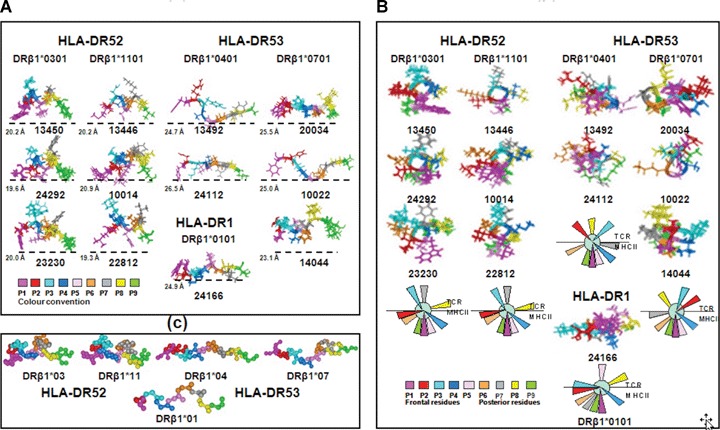Fig 6.

(A) Lateral view of the three-dimensional (3D) structure of some immunogenic protection-inducing modified malarial HABPs (determined by 1H NMR), according to their HLA-DRβ1* binding activity, binding motifs and reading registers. The only HLA-DRβ1*0101 peptide is shown at the bottom of the HLA-DRβ1*0401 column. Colour code for amino acids fitting into pockets and their localization is displayed at the bottom of each figure. Modified HABPs fitting into haplotype DR52 (HLA-DRβ1*0301 and HLA-DRβ1*1101) had 20 ± 1.5 Å distance and those fitting into purified HLA-DRβ1*0401 and HLA-DRβ1*0701 molecules (haplotype DR53) had a 25 ± 1.5 Å distance between the farthest atoms fitting into Pockets 1 to 9, supporting the existence of about 2 Å difference in distance between different HLA-DR haplotypes' Pockets 1 to 9. (B) Front view of some immuno-genic-protection-inducing peptides' 3D structure determined by 1H NMR. A consensus diagram of front-view residue orientation is shown at the bottom. Residues opposed and perpendicularly orientated downwards fit into P1 (fuchsia, forward) and P9 (green, backwards). Residues fitting into P4 (dark blue) and P6 (light brown) are orientated to adjust into the corresponding lateral pockets of the peptide-binding region shallow floor. Any amino acid orientated on the same plane (or lower down) suggested the existence of pockets other than 1, 4, 6 or 9 in these Class II molecules. A putative Pocket 2 for HLA-DR52 haplotype alleles and a putative Pocket 7 for HLA-DR53 haplotype molecules can thus be suggested since these residues are localized at the same HLA-DR platform level as canonical Pockets 4 and 6. Upwardly orientated residues, being opposite to these pockets, could be binding to the TCR; therefore, residues 3, 7 and 8 in HLA-DR52 alleles 2, 3 and 8 in HLA- DR53 alleles and residues 3, 5 and 8 for haplotype DR1 could be making contact with the TCR. All these data suggest haplotype- and allele-conscious TCR differences in immunogenic-protection-inducing anti-malarial modified HABPs. (C) Top view of the backbone atoms of the superimposed immunogenic, protection-inducing, modified, malarial HABPs binding to the HLA-DR molecules displayed above showing the different distances between these residues fitting into Pockets 1 (fuchsia) and 9 (green), among the different haplotype-binding HABPs and their different orientation between residues P2 (red) and P7 (grey) amongst different haplotypes and alleles binding modified HABPs. RMSD was <1.00. Such differences in length and orientation for the different haplotypes have to be seriously taken into account when designing vaccines.
